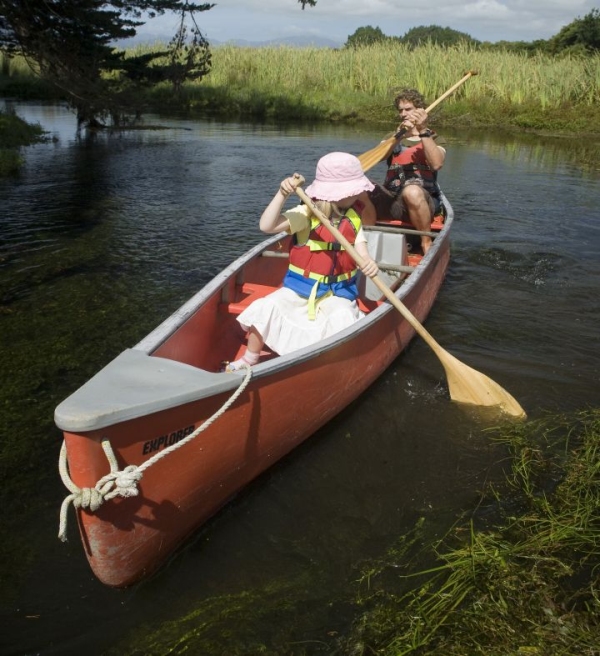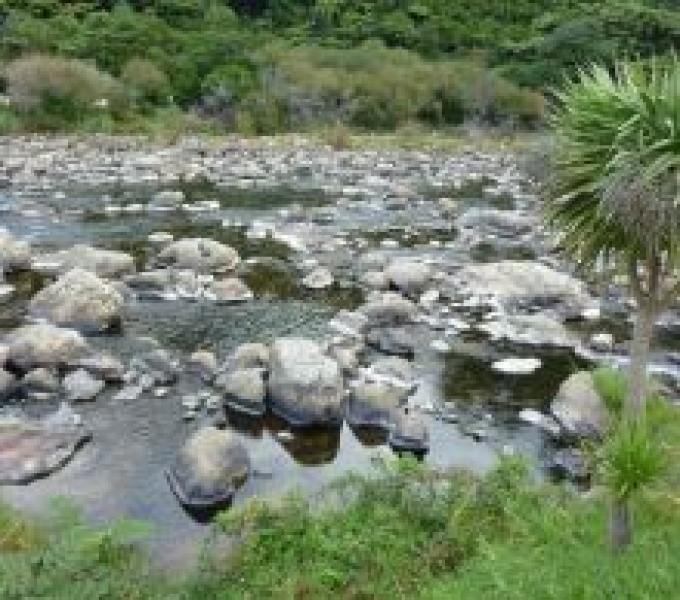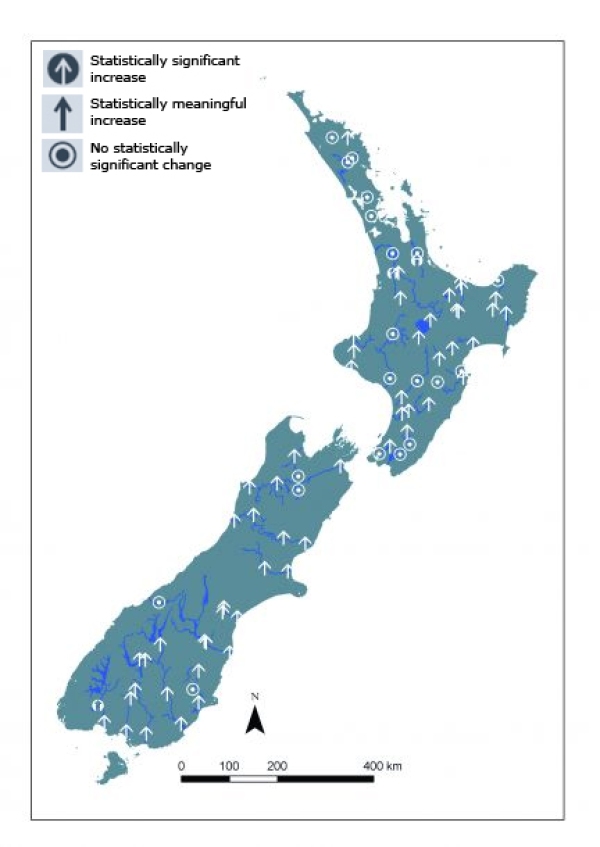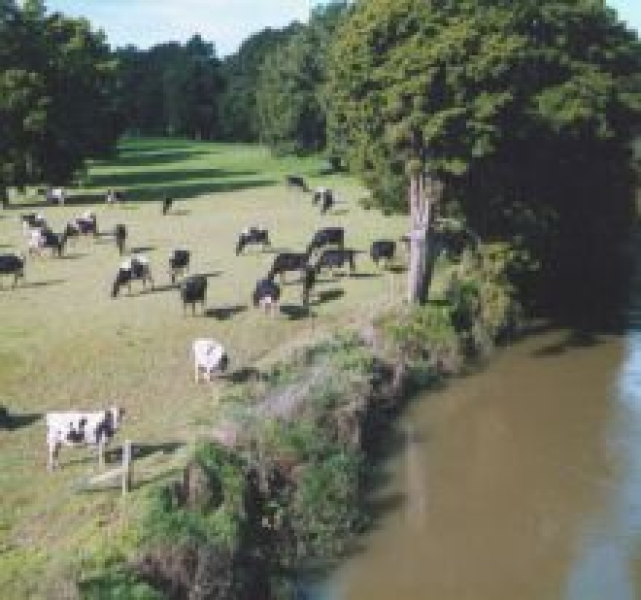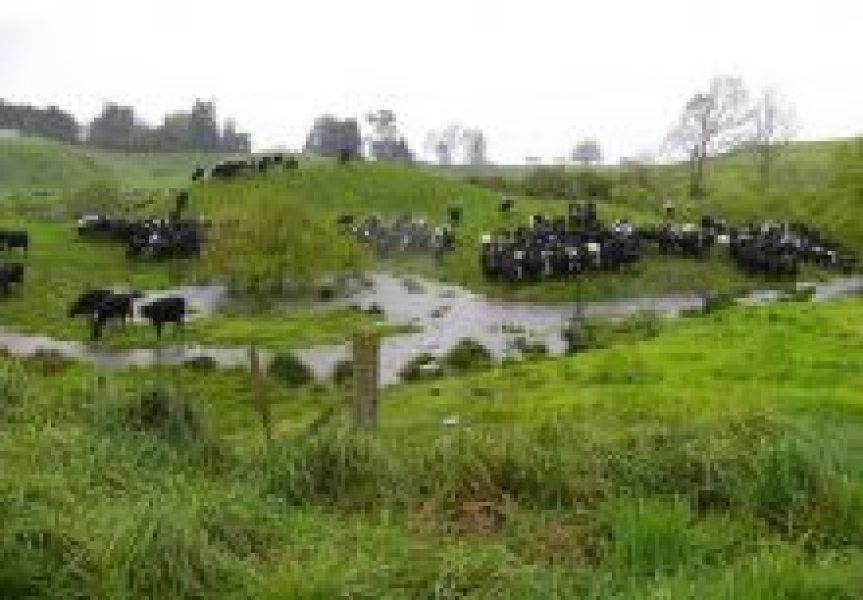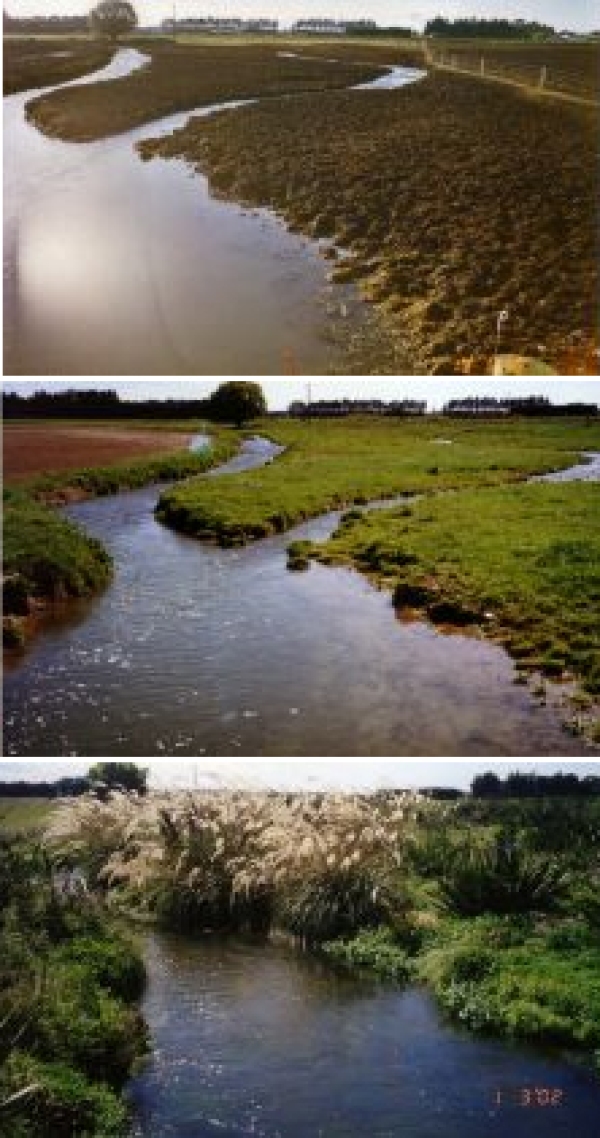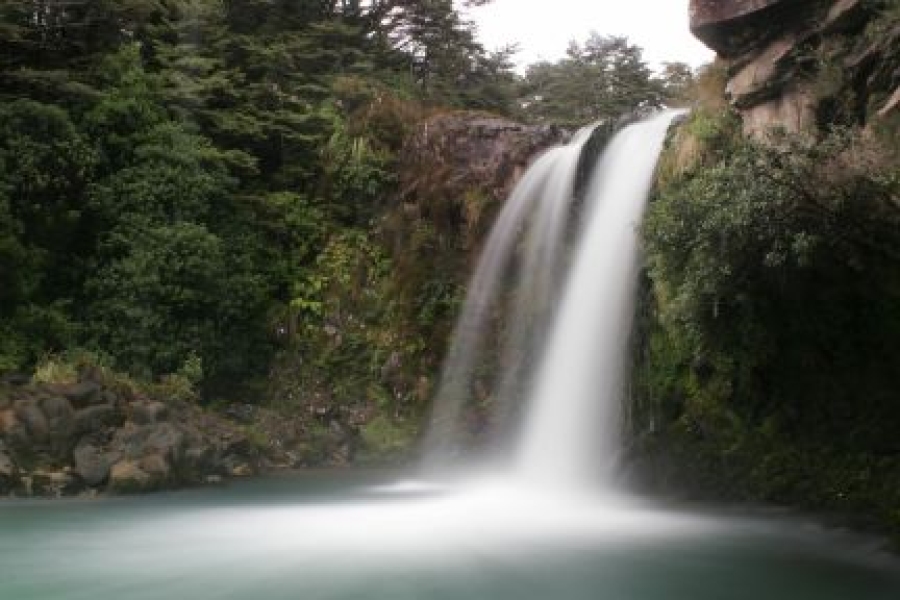Fiona Proffitt investigates the state of New Zealand's freshwater resources and the solutions science can offer
As New Zealand tries to squeeze maximum value out of its natural resources, conflicts over water are coming to a boil. We’re fast approaching water resource limits in some parts of the country, and pollution issues are threatening our clean, green brand.
Despite a comprehensive clean-up of dirty ‘point-source’ discharges in the 1990s, water quality in many of our lakes and rivers is still declining. The cause this time is ‘diffuse-source’ pollution associated with intensive land use, particularly pastoral farming.
So how do we balance the drive to grow our economy with the need for clean water? Can our freshwater systems sustain the spread of intensive dairying?
These are the kinds of issues exercising the Land and Water Forum, a stakeholder group charged with finding a collaborative solution to water resource issues. The Forum is a key part of the Government’s new agenda for managing our freshwater resources: New Start for Fresh Water. Reforms to the Resource Management Act (RMA) have already established an Environmental Protection Agency and given ministers powers to call in decisions on big proposals, like those in the recently stalled cubicle dairying proposal for the Mackenzie Basin.
Meanwhile, accusations of dirty dairying, conflicts over irrigation proposals, and the swimmable status of our waters continue to grab headlines. Respondents to a 2008 opinion poll by consultants EOS Ecology rated water pollution and water-related issues as the number one environmental issue facing New Zealand. So how bad is it really, and what solutions can science offer?
Status and trends in water quality
Sustained national-scale monitoring is fundamental to determining the state of our freshwaters, the impacts of land use changes, and the success of clean-up efforts. The country’s only national-scale monitoring programme, the National Rivers Water Quality Network (NRWQN), is operated by NIWA. Currently, this provides the best source of national-scale water quality data in New Zealand. The network regularly samples 77 sites, including 35 major rivers that drain 50 percent of our land area. “It gives a really good overview of what’s going on” with water quality, says Todd Krieble, Director of Information at the Ministry for the Environment (MfE). NRWQN data are freely available online.
Regional councils also monitor water quality for state of the environment (SoE) reporting at about 500 sites. “The overall picture emerging from the NRWQN is that our water quality, while generally good by international standards, is declining,” says NIWA freshwater scientist Rob Davies-Colley. Many rivers show excessive nutrients, reduced visual clarity due to suspended sediments, and pollution by faecal bacteria. Water quality is appreciably worse at several hundred sites in lowland rivers monitored by regional councils.
Trends in NRWQN data between 1989 and 2007 (published on the MfE website) show an overall degradation in water quality in our major rivers. Over that period, nitrogen and phosphorus – key plant nutrients added in fertilisers – increased strongly at many sites. Nitrogen increased by about 1.4 percent per annum over most of the country, but remained steady at pristine sites like the Haast River; no sites recorded a drop in nitrogen concentrations (see map). Trends for phosphorus were mostly upwards. Another cause for concern is that upward trends for temperature, nitrogen, and phosphorus have strengthened in recent years compared with the period 1989–2003.
There were no statistically significant or meaningful decreases. A ‘meaningful’ trend is one which is statistically significant, with a rate of change greater than 1% per annum, and which is likely to be environmentally meaningful (being perceptible in less than a human lifetime). A ‘significant’ trend is one which is statistically significant at the 95% confidence level, but with a rate of change less than 1% per annum (which is unlikely to be environmentally meaningful). [Note: The first two symbols were swapped in the print version of this map but have been corrected in this online version. The majority of data points showed 'statistically meaningful increase'. (rev. 13 Aug 2010)].
Water quality information for lakes, groundwater, and estuaries is much patchier, as there is currently no nationalscale monitoring for these water bodies. (The NRWQN monitored 35 lakes from 1989 until 1996, when funding for lake monitoring was cut.) Regional council monitoring published by MfE in 2006 tells us that many of our lakes are in bad shape: of 134 lakes monitored, 56 percent are ‘eutrophic’ or worse. This means they suffer from nutrient enrichment that promotes frequent algal blooms, including major blooms of toxic cyanobacteria, a type of algae that has plagued central North Island and some South Island lakes over the past decade.
These changes all have consequences for how we use our freshwater resources – whether it’s for drinking, stock watering, food harvesting, or recreational activities – and for their aesthetic qualities, ecological functioning, and spiritual integrity or ‘mauri’. MfE is attempting to establish national water quality standards for these different uses. The ministry recently published league tables for rivers in the NRWQN on its website, based on water quality percentiles for different variables, such as clarity and levels of faecal bacteria. For this issue of Water & Atmosphere, NIWA scientists have analysed the same data, to assess the ‘swimmability’ of the 77 rivers (see 'Should I Swim in This?').
Contaminants from the land
The NRWQN and regional SoE monitoring show that diffuse pollution from land use is overwhelmingly the main cause of water quality degradation in New Zealand today. Research and monitoring have identified nitrogen (particularly its dissolved form, nitrate), phosphorus, faecal microbes, and sediments as the key contaminants from diffuse sources.
Pastoral farming – which accounts for 40 percent of New Zealand’s land area – is undoubtedly the main source of diffuse pollution. Evidence from the NRWQN and catchment studies generally show a gradient in water quality from excellent in native forest, to good in plantation forest, to poor in pastoral and urban streams. Streams in dairy land are among the most polluted.
There is no doubt that our declining river water quality over the last 20 years is associated with intensification of pastoral farming and the conversion of drystock farmland to dairy farming, particularly in Waikato, Southland, and Canterbury. For example, between 1992 and 2002, the number of cows in Waikato increased by 37 percent; during the same period nitrogen levels in the region’s streams increased by 40 percent and phosphorus levels went up by 25 percent.
We know that New Zealand’s aquatic systems are particularly sensitive to nitrogen and phosphorus, so even small increases can have marked effects. “There’s an order of magnitude of difference between the amount of nutrient required to get good pasture growth and the amount, particularly of nitrate, that causes problems in waterways,” says Neil Deans, Resource Management Coordinator for Fish & Game New Zealand. “If you add that to the time lags between surface water inputs and outputs, you have a big problem.”
“Dairy farming is a very leaky process,” says NIWA physical chemist Bob Wilcock. Using results from nutrient budget modelling, the Ministry of Agriculture and Forestry (MAF) reported in 2008 that the average nitrogen lost from the soil on dairy farms was 39 kilograms per hectare per year, compared with 12 kilograms for deer farms and 8 kilograms for sheep and beef farms. Substantial quantities of nutrients, sediments, and faecal bacteria can wash into pastoral streams, particularly on steep country, during rainstorms.
Cattle also cause significant damage to ‘riparian’ habitats along the edges of streams, wetlands, and lakes. This can radically alter stream ecology by increasing sediment loads (reducing water clarity) and removing riparian plants, which are an important natural feature of streams. These plants provide cover for fish and invertebrates, and shade the water. Without this shade, the higher water temperatures and light levels become stressful for some stream species. When coupled with nutrient enrichment, they promote the growth of periphyton (nuisance riverbed algae) and undesirable water weeds in summer when water flow is low.
There is now considerableevidence that the combined effect of light exposure, bank damage by livestock, and poor water quality has substantially degraded the ecological health of pastoral streams. Nutrient enrichment, when combined with sediments and other stressors, can cause irreversible shifts in aquatic ecosystems, particularly in downstream lakes and estuaries.
Once they reach coastal waters, the combined effects of sediments, nutrients, and urban contaminants (such as heavy metals washed off roads and roofs) degrade water quality, ecosystems, and fisheries. In addition, faecal microbes render shellfish unfit for human consumption, which reduces opportunities for kaimoana harvest, and threatens New Zealand’s burgeoning aquaculture industry.
“The real impact of diffuse pollution on ecosystems downstream is multiple stressors: one stressor almost never works on its own,” says Clive Howard-Williams, NIWA’s Chief Scientist, Freshwater.
The picture is further complicated by time lags in groundwater systems, with water sometimes taking decades after falling as rain before emerging as springs into surface water. “Because of these time lags in some catchments, we’re only now seeing the effects of farming practices in the ’60s and ’70s, and it’s going to be another 30–40 years before we see the effects of current practices,” says Dr Howard-Williams.
Fixing the problems: lessons from research
Restoring water quality to its original state, or even rehabilitating lakes and rivers to a swimmable condition, can be an expensive business. Efforts to stem pollution and repair the damage must be targeted and cost-effective. “It’s about not trying to do everything everywhere, but doing the right thing in the right places,” says NIWA freshwater scientist John Quinn.
Science can help guide mitigation measures where they’ll give the ‘biggest bang for buck’ by identifying the key contaminants, pollution hotspots, and pathways in different catchments. Sophisticated computer models that can model nutrient and sediment transport and the dynamics of water flow are playing an increasingly important role in this.
“Science is hugely important because we understand in principle that there is a link between water quality and the intensity of adjacent land use,” says Fish & Game’s Neil Deans, “but with diffuse pollution it’s very difficult to attribute it to a particular land use. What we need is to have these models as sophisticated as possible to be well informed about the levels of intensification that can be sustained downstream. And also the effectiveness of riparian buffers and other techniques such as nitrate inhibitors.”
Catchment-based research like the Mangaotama project in the Waikato hill country (see sidebar) has demonstrated that protecting and restoring riparian land and wetlands – through fencing and planting – can achieve big improvements in water quality for a relatively small investment. Riparian and wetland areas often occupy less than 10 percent of the catchment, but can partially buffer waters from the worst effects of intensive pastoral agriculture. They do this by filtering contaminants, shading streams, and excluding livestock from water bodies.
But riparian buffers can do little with nutrients that are fasttracked into streams by underfield tile drains, particularly in high rainfall areas, says NIWA aquatic pollution scientist Chris Tanner. Tile drains are used under pastures in poordraining areas, particularly on flat land with heavy clay soils. Annual nitrogen losses from tile drains in intensively grazed dairy pastures in New Zealand commonly range from 20–60 kilograms of nitrogen per hectare, which can pose a significant threat to sensitive receiving waters, including estuaries.
Artificial or ‘constructed’ wetlands offer a cost-effective, practical option for intercepting tile drainage flows and treating contaminants, says Dr Tanner. Denitrifying bacteria in the wetlands remove nitrogen (including nitrate) by converting it to nitrogen gas. Tanner and his colleagues at NIWA have developed guidelines to enable farmers to construct wetlands to treat their tile-drain discharges. The guideline recommendations are based on the results and modelling of farm-scale trials in Waikato, Northland, and Southland.
Collaborations between the dairy industry, scientists, and local government are identifying mitigation measures that will work in different parts of New Zealand through the Best Practice Catchments for Sustainable Dairying programme. This industry-initiated programme, jointly funded by MAF and DairyNZ, is identifying and testing a host of best management practices (BMPs) farmers can apply to minimise impacts on streams. These include: better handling of dairy shed effluents; nutrient budgeting to balance nutrient inputs with soil needs;providing herd homes to minimise soil damage in wet weather; and excluding stock from the streams by installing bridges, culverts, and riparian fencing.
While such studies demonstrate that BMPs can be effective, there can’t be a ‘one size fits all’ approach in a country as diverse as New Zealand. “Stock exclusion and riparian planting all reduce inputs of sediments, nutrients, and bacteria to different degrees, but they will all have varying degrees of success depending on local conditions, such as the climate or topography,” says Shirley Hayward, a water quality specialist with DairyNZ’s sustainability team.
The effectiveness of different mitigation strategies will also depend on what’s causing the problem – whether it’s nutrients, sediments, bacteria, or lack of stream shading. “Science can help identify the priority areas for intervention,” says Ms Hayward. “Nitrate may not always be the most important area to address.” While nutrients appear to be the main issue for lakes, sediments and lack of shade may be more important for small lowland streams, she says. For these streams, you won’t restore the ecosystem by controlling nitrate; you have to deal with the issues of sediment and shading.
Identifying contaminant limits
“Getting the stock out of streams isn’t going to be enough where there is a high intensity of farming,” says Mr Deans. “What we’re beginning to see is that the land-use outputs themselves need control.”
To assist management agencies to set overall contaminant load limits, scientists need to identify the key contaminants and the ecological thresholds or tipping points at which water quality and ecosystem functioning begins to degrade rapidly. “This is something scientists are getting close to for some systems,” says NIWA’s Dr Howard-Williams.
“To make accurate predictions, we need to better understand the ecological and hydrological dynamics, interactions among multiple stressors, cumulative effects, and time lags in freshwater systems. Water policy and management need to take account of these complexities, which provides a challenge for the management of our freshwaters.”
Interactions between water quality and quantity (flows) are an important area of emerging research. High nutrient pollution levels, for instance, have a much stronger impact on rivers and streams at low flow. Streams and riverbeds benefit from periodic flushing flows that clear away nuisance periphyton and fine bed sediment, so any changes to water flow – for example through extraction for irrigation or hydro-scheme storage – need to be considered alongside activities that affect water quality.
Regional councils have traditionally managed water flow and quality issues separately and have approved multiple small extraction and discharge consents without consideration for their total effects. But now there’s greater recognition of cumulative effects – the adding up of many small extraction and discharge activities over space and time – and some regional councils are setting nutrient load limits for catchments as part of their regional plans. The next step is to work out how to achieve those limits: for this, allocation mechanisms may become increasingly important.
Applying the numbers: limiting contaminant inputs
Scientists are beginning to identify the key contaminant issues and limits for some water bodies through detailed research and modelling, providing the numbers to guide good management.
NIWA is collaborating on research of nutrients feeding into some iconic lakes. Research with the universities of Waikato and Otago, for instance, has identified nitrogen as the key contaminant for Lake Taupo and Lake Rotorua. As a result, regional councils and stakeholder groups are considering nitrogen cap-and-trade schemes for both lakes. This radical management approach would involve allocating nitrogen outputs among different users to achieve a desirable water quality target.
The best scientific evidence suggests we need to reduce nitrogen load in Lake Taupo by 20 percent to maintain its health in the long term and avoid a costly catastrophe. Farms occupy only 18 percent of the surrounding land, but contribute more than 90 percent of the manageable nitrogen input to the lake. In their regional plan, Environment Waikato chose to adopt a relatively simple system of managing nutrient loads in Lake Taupo by focusing on farm exports of nitrogen rather than total lake inputs. Each farmer is allocated an annual nitrogen discharge allowance, which they can trade with other farmers. The downside is that it doesn’t take account of natural attenuation of nitrogen between the farm and the lake, or groundwater time lags (nitrogen that drains into groundwater can take decades to reach the lake).
Developing a nitrogen trading scheme that controls lake inputs is a much more challenging proposition, both scientifically and administratively. Environment Bay of Plenty (EBoP) has set a target of reducing nitrogen inputs to Lake Rotorua to 435 tonnes per year, the input during the early 1960s. There is a feasibility study to develop such a scheme for Lake Rotorua, using NIWA’s N-trader model to simulate a nutrient trading market. This will be a test case for developing nutrient trading schemes elsewhere in New Zealand.
While we’re identifying limits for some iconic and vulnerable water bodies, we’ve barely begun this process for the majority of our rivers and lakes. As it’s unrealistic to achieve this level of investment for all of New Zealand’s water bodies, what we need is a way to extrapolate from detailed case studies to the rest of the country. New spatial modelling techniques and classification systems like NIWA’s River Environment Classification offer a tool for achieving this. By grouping rivers together on the basis of physical similarities, we can apply knowledge from well-studied rivers to similar rivers elsewhere.
“Because many of the issues we’re facing with water quality – such as diffuse pollution from land use – are large scale, we need to do large-scale science,” says Dr Howard- Williams. New Zealand needs to scale-up its water quality monitoring, databases, and modelling to a national level. But we also need to capture the enormous differences across the country, which requires catchment-scale studies, integrated through spatial frameworks such as the River Environment Classification.
Beyond the numbers: agreeing objectives
While scientists can, given sufficient time and information, identify the impacts of different land-use scenarios on water quality, it’s up to the wider community to decide what water quality values they want to protect.
“Water quality is not just about numbers, it’s also about the relationship people have with water,” says DairyNZ’s Shirley Hayward. Water quality objectives vary, depending on the ecological, cultural, or economic value we attach to different water bodies. For national treasures, such as Takaka’s Waikoropupu Springs or the Haast River, nothing short of pristine will do, whereas New Zealanders may choose to accept a lower standard for a pastoral or urban stream.
Under the New Start for Fresh Water strategy, the Government has signalled a ‘collaborative governance’ approach to working out water quality objectives and hammering out conflicts. This is happening at a local level in some areas, most notably over the clean-up of Lakes Taupo and Rotorua, and for the Waikato River, where a co-management approach is being pioneered.
The Land and Water Forum represents collaborative governance at a national level. The first part of its work has involved getting major stakeholders together and finding out what their goals and strategies are, says Forum Chairman Alastair Bisley. The Forum is due to report back to the Government with some options for water management reform by the end of August.
The future: hopes and challenges
“New Zealand’s future depends on having environmentally sustainable land use…. The real underlying question is: can we sustain these rates of intensification?” says Fish & Game’s Neil Deans.
The fact that some heavily polluted rivers – mostly in dairying areas – have turned the corner in recent years gives us cause for optimism for the future, says Dr Davies-Colley. For instance, the NRWQN shows water quality has improved in some Taranaki rivers and the Manawatu. A programme of widespread riparian fencing and planting in Taranaki probably explains most of the improvement there, he says.
But although science identified the effectiveness of these measures 15 years ago, implementation has been lacking, according to Mr Deans. “There’s a bit of fiddling while Rome burns, I’m afraid. Unless we take action, we’re going to see continuing water degradation and be in a worse position in five or ten years’ time.”
While many dairy farmers are improving their environmental performance, the latest results from the Dairying and Clean Streams Accord – a voluntary agreement among Fonterra’s suppliers – are disappointing. And while it’s a laudable initiative, the Accord excludes small streams, where the greatest effects of dairying are seen, says Deans.
As NIWA scientist Bob Wilcock points out, best management practices on dairy farms are effective in some situations, but they can do only so much. “We also need to identify high and low risk areas for dairying.” He’s concerned about the expansion of dairying into high rainfall or heavily irrigated areas where there’s a greater risk of contaminants getting washed into waters.
Water-sensitive land designs offer a way of moderating the impact of land use on water quality. “These are about looking at the sensitivity of waters, key limiting factors, and going back to the land and designing land use and mitigation measures to fit those,” explains NIWA scientist John Quinn. “It’s about applying knowledge to develop the best solution to protect waters while still allowing productive use of the land.”
The Mangaotama catchment study is proof that environmental and economic goals can be met within some catchments when land use is matched to the conditions. But scientists agree that some water quality degradation is inevitable with intensive land use, whether it be dairy farming or urban development.
Find out more about the Mangaotama catchment study
“New Zealand may need to consider rolling back from intensive land use in some catchments where even ‘best practice’ will not be sufficient to meet water quality targets,” says Dr Davies-Colley.
One thing is certain: we’re facing some tough decisions over New Zealand’s water resources. More than ever, we need robust science to inform the debate.
Dr Fiona Proffitt, NIWA science writer

